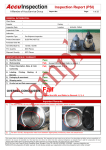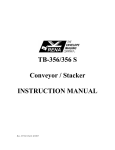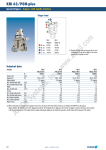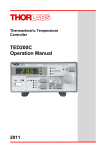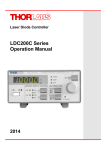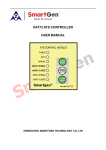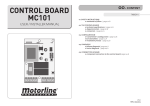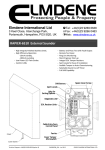Download Diode Laser Driver User Manual
Transcript
dld_manual_JimV7.qxd 3/3/2006 10:28 AM Page 1 1 The Practical Application of Light Create Control Position Light Diode Laser Driver User Manual dld_manual_JimV7.qxd 3/3/2006 10:28 AM Page 2 dld_manual_JimV7.qxd 3/3/2006 10:28 AM Page i NOTICE: This manual contains specifications, descriptions, and drawings of the diode laser drivers provided by Melles Griot. Product specifications contained in this manual are subject to change by Melles Griot without prior notice. Melles Griot will not be responsible for errors or omissions in this manual, or for incidental or consequential damages in connection with the furnishing or use of this information. The information contained in this manual is the property of Melles Griot. This document may not be photocopied, duplicated, or reproduced by any means without the prior written consent of Melles Griot. Comments or suggestions regarding this manual are appreciated and should be sent to the following address: Melles Griot Photonics Components Group 2051 Palomar Airport Road, 200 Carlsbad, California 92011, USA Attention: Customer Service Phone (760) 238-5131 Fax (760) 804-0049 E-mail: [email protected] Publication date: February 2006 © 2006 Melles Griot i 1 dld_manual_JimV7.qxd 3/3/2006 10:28 AM Page ii dld_manual_JimV7.qxd 3/3/2006 10:28 AM Page iii TABLE OF CONTENTS INTRODUCTION . . . . . . . . . . . . . . . . . . . . . . . . . . . . . . . . . . . . . . . . . . . . . . . . . . . . . . . . . . . . . . . . . . . . . . . . .1 1 GENERAL DESCRIPTION . . . . . . . . . . . . . . . . . . . . . . . . . . . . . . . . . . . . . . . . . . . . . . . . . . . . . . . . . . . . . . .2 1.1 1.2 1.3 1.4 1.5 1.6 1.7 1.8 1.9 Packing list . . . . . . . . . . . . . . . . . . . . . . . . . . . . . . . . . . . . . . . . . . . . . . . . . . . . . . . . . .2 Safety . . . . . . . . . . . . . . . . . . . . . . . . . . . . . . . . . . . . . . . . . . . . . . . . . . . . . . . . . . . . . .2 Warranty . . . . . . . . . . . . . . . . . . . . . . . . . . . . . . . . . . . . . . . . . . . . . . . . . . . . . . . . . . . .2 Features . . . . . . . . . . . . . . . . . . . . . . . . . . . . . . . . . . . . . . . . . . . . . . . . . . . . . . . . . . . .3 Technical data . . . . . . . . . . . . . . . . . . . . . . . . . . . . . . . . . . . . . . . . . . . . . . . . . . . . . . . .4 1.5.1 Individual data . . . . . . . . . . . . . . . . . . . . . . . . . . . . . . . . . . . . . . . . . . . . . . . . . .4 1.5.2 Common data . . . . . . . . . . . . . . . . . . . . . . . . . . . . . . . . . . . . . . . . . . . . . . . . . .5 Ordering codes and accessories . . . . . . . . . . . . . . . . . . . . . . . . . . . . . . . . . . . . . . . . . .5 Operating elements . . . . . . . . . . . . . . . . . . . . . . . . . . . . . . . . . . . . . . . . . . . . . . . . . . .6 1.7.1 Operating elements on the front panel . . . . . . . . . . . . . . . . . . . . . . . . . . . . . .6 1.7.2 Operating elements on the rear panel . . . . . . . . . . . . . . . . . . . . . . . . . . . . . . .7 Initial settings . . . . . . . . . . . . . . . . . . . . . . . . . . . . . . . . . . . . . . . . . . . . . . . . . . . . . . . .7 Connecting components . . . . . . . . . . . . . . . . . . . . . . . . . . . . . . . . . . . . . . . . . . . . . . .8 1.9.1 9-pole sub-D output jack . . . . . . . . . . . . . . . . . . . . . . . . . . . . . . . . . . . . . . . . . .8 1.9.2 Interlock and control LED for LASER ON . . . . . . . . . . . . . . . . . . . . . . . . . . . . . .8 1.9.3 Connecting the laser diode and photodiode . . . . . . . . . . . . . . . . . . . . . . . . . .9 1.9.4 Analog control output for the laser current . . . . . . . . . . . . . . . . . . . . . . . . . .10 2 OPERATING INSTRUCTIONS . . . . . . . . . . . . . . . . . . . . . . . . . . . . . . . . . . . . . . . . . . . . . . . . . . . . . . . . . .11 Setting the Current Limit ILIM . . . . . . . . . . . . . . . . . . . . . . . . . . . . . . . . . . . . . . . . . . .11 Selecting the diode laser polarity . . . . . . . . . . . . . . . . . . . . . . . . . . . . . . . . . . . . . . . .11 Constant current mode (CONST I) . . . . . . . . . . . . . . . . . . . . . . . . . . . . . . . . . . . . . . .12 Constant power mode (CONST P) . . . . . . . . . . . . . . . . . . . . . . . . . . . . . . . . . . . . . . .12 2.4.1 Changing the "IPD" setting range . . . . . . . . . . . . . . . . . . . . . . . . . . . . . . . . . .13 2.5 Calibrating the optical power display . . . . . . . . . . . . . . . . . . . . . . . . . . . . . . . . . . . . .14 2.6 Analog modulation of the diode laser . . . . . . . . . . . . . . . . . . . . . . . . . . . . . . . . . . . .14 2.1 2.2 2.3 2.4 3 REMOTE CONTROL . . . . . . . . . . . . . . . . . . . . . . . . . . . . . . . . . . . . . . . . . . . . . . . . . . . . . . . . . . . . . . . . . . .15 4 MAINTENANCE . . . . . . . . . . . . . . . . . . . . . . . . . . . . . . . . . . . . . . . . . . . . . . . . . . . . . . . . . . . . . . . . . . . . . . .16 4.1 4.2 4.3 4.4 4.5 4.6 Line voltage . . . . . . . . . . . . . . . . . . . . . . . . . . . . . . . . . . . . . . . . . . . . . . . . . . . . . . . .16 Replacing the line fuse . . . . . . . . . . . . . . . . . . . . . . . . . . . . . . . . . . . . . . . . . . . . . . . .16 General care . . . . . . . . . . . . . . . . . . . . . . . . . . . . . . . . . . . . . . . . . . . . . . . . . . . . . . . .17 Cleaning . . . . . . . . . . . . . . . . . . . . . . . . . . . . . . . . . . . . . . . . . . . . . . . . . . . . . . . . . . .17 Repair . . . . . . . . . . . . . . . . . . . . . . . . . . . . . . . . . . . . . . . . . . . . . . . . . . . . . . . . . . . . .17 Troubleshooting . . . . . . . . . . . . . . . . . . . . . . . . . . . . . . . . . . . . . . . . . . . . . . . . . . . . .17 5 LISTINGS . . . . . . . . . . . . . . . . . . . . . . . . . . . . . . . . . . . . . . . . . . . . . . . . . . . . . . . . . . . . . . . . . . . . . . . . . . . . . .18 5.1 5.2 5.3 5.4 List of acronyms . . . . . . . . . . . . . . . . . . . . . . . . . . . . . . . . . . . . . . . . . . . . . . . . . . . . .18 List of figures . . . . . . . . . . . . . . . . . . . . . . . . . . . . . . . . . . . . . . . . . . . . . . . . . . . . . . .18 Certifications and compliances . . . . . . . . . . . . . . . . . . . . . . . . . . . . . . . . . . . . . . . . . .19 Addresses . . . . . . . . . . . . . . . . . . . . . . . . . . . . . . . . . . . . . . . . . . . . . . . . . . . . . . . . . .20 iii 1 dld_manual_JimV7.qxd 3/3/2006 10:28 AM Page iv dld_manual_JimV7.qxd 3/3/2006 10:28 AM Page 1 Introduction This instruction manual contains all the specific information necessary to operate the 06 DLD 3xx series of diode laser drivers. Chapter 1 provides a general description of the laser driver. Chapter 2 provides complete instructions for operating the system manually. Chapter 3 outlines a simple method for remotely controlling the driver. Chapter 4 describes the routine maintenance functions that should be performed by the operator. Chapter 5 contains a listing of the acronyms used in this manual, along with a listing of figures, compliance data, and pertinent addresses. Warning! This manual contains WARNING labels, in this form, to indicate personal danger or possible damage to equipment. Please read these carefully! NOTE: This manual also contains notes and hints written in this form. 1 1 dld_manual_JimV7.qxd 3/3/2006 10:28 AM Page 2 Chapter 1 General Description 1.1 Packing List When unpacking the diode laser driver, the following items should be found: E The 06 DLD 3xx diode laser driver E The power cord with a connector corresponding to the ordering country E The user manual E The 06 DLH 301 connection cable If any of these items are missing, contact your nearest Melles Griot representative. 1.2 Safety Warning! All statements regarding safety of operation and technical data in this instruction manual will apply only when the unit is operated in accordance with this user’s manual. Before applying power to your 06 DLD 3xx diode laser driver, make sure that the protective conductor of the 3-conductor power cord is correctly connected to the protective ground contact of the socket outlet, as improper grounding can cause a potentially fatal shock. The line voltage setting marked on the rear panel must agree with your local supply, and corresponding line fuses must be used. If the voltage setting is incorrect, contact Melles Griot to request a service technician change the voltage. The customer can change the line fuse. Laser and photodiodes must be connected only with shielded connection cables. Warning! Improper grounding can cause a potentially fatal electric shock. The unit must not be operated in an explosive environment! Caution! Use of mobile telephones, handy phones, or other radio transmitters within three meters of the diode laser drive could cause the electromagnetic field intensity to exceed the maximum values allowed by EN 50 082-1. 1.3 Warranty Melles Griot warrants the 06 DLD 3xx series of diode laser drivers against defects in material and workmanship for a period of twelve months from the date of purchase. Melles Griot will, at its own option, repair or replace without charge any item found to be defective within this period. Melles Griot standard terms and conditions of sale apply during the warranty period. To authorize a return, contact Melles Griot to obtain a return material authorization (RMA) number. The customer is responsible for all shipping costs to Melles Griot. For warranty 1 2 dld_manual_JimV7.qxd 3/3/2006 10:28 AM Page 3 repairs, Melles Griot will pay the return shipping costs. For nonwarranty repairs, the customer is responsible for shipping costs in both directions. In the case of international shipments, the customer is responsible for all applicable duties, taxes, and fees. The diode laser driver must be returned to Melles Griot in its complete original packaging, including the plastic foam parts. If necessary, ask for a replacement package. This warranty is void if E The driver is exposed to extraordinary environmental extremes including but not limited to the following: excessive heat or cold; accumulated dust; water damage; excessive input voltage; exposure to electrostatics; excessive shock or vibration; improper return packing, shipping or handling; or improper operation or application. E The customer attempts to adjust laser power components. E The customer attempts to repair or replace components beyond the scope described in the maintenance section of this manual. 1.4 Features The 06 DLD 3xx-series diode laser drivers from Melles Griot are extremely precise current controllers for diode lasers and LEDs. Both the injection current and the optical output power output of a diode laser can be controlled simultaneously by using a Melles Griot temperature controller in conjunction with the driver. To protect the diode laser against damage, the 06 DLD 3xx diode laser drivers provide the following protection features: E Softstart function E Adjustable limitation of injection current E Interlock (open-circuit monitoring of the laser diode mount connection) E Electronic short circuit for the laser diode in off-mode E Separate control to switch the laser diode current on and off E Monitoring LED for LASER ON mode The 06 DLD 3xx-series diode laser drivers are easy to use because of the intuitively structured front panel. Operating parameters are shown on an illuminated 4½-digit LCD display. The parameter to be displayed is selected with UP and Down buttons. An on/off delay and the softstart function protect the diode laser against undesired transients. An independent hardware limit for the injection current, set with a 20-turn potentiometer, protects the diode laser from operating errors. With the output open the laser diode is short circuited electronically so that no voltage is applied to the diode laser. When turned on, the 06 DLD 3xx diode laser driver automatically defaults to the LASER OFF mode. The laser current can then be switched on and off with a separate button located in the front panel. The diode laser or photodiode is connected to the driver via a 9-pin sub-D socket at the rear of the unit. Because the output for the diode laser and the input for the photodiode are bipolar, all polarities of commercially available diode lasers can be used. A control signal located at the output jack can operate an external LED to indicate a LASER ON condition. 3 1 dld_manual_JimV7.qxd 3/3/2006 10:28 AM Page 4 The injection current or the optical output power of the diode laser can be modulated via a modulation input at the rear of the unit. For monitoring purposes, a voltage proportional to the diode laser current is provided at an analog control output at the rear. If an error occurs or if the limit for the laser current is reached, the corresponding LED lights up and a short warning beep sounds. A line filter coupled with careful transformer shielding provides low ripple and noise at the output, and internal cooling of the diode laser driver with a fan protects the unit against overheating in case of high environmental temperature. With free air circulation, safe operation of the unit is guaranteed up to 40°C ambient temperature. Warning! Do not obstruct the air-ventilation slots in the housing! 1.5 Technical Data 1.5.1 Individual Data 06 DLD 301 06 DLD 302 06 DLD 303 Constant current mode: Control range (continuously variable) Setting accuracy Resolution Compliance voltage Noise (10 Hz–10 MHz) Ripple (50 Hz, rms) Transients Short-time fluctuations (15 sec, 0–10 Hz) Temperature coefficient Drift (30 min, 0–10 Hz) 0–200 mA 0.1 mA 0.01 mA >6V < 1.5 mA < 1.5 mA < 200 mA < 10 mA 50 ppm/°C 20 mA 0–500 mA 0.1 mA 0.1 mA >4V < 3 mA < 2 mA < 500 mA < 10 mA 50 ppm/°C 50 mA 0–2 A 2 mA 0.1 mA >4V < 15 mA < 5 mA < 100 mA < 2 mA 50 ppm/°C 200 mA Constant power mode: Control range photodiode current Setting accuracy Resolution photodiode current Resolution optical power 5 mA–2 mA 2 mA 0.1 mA 1 mW 5 mA–2 mA 2 mA 0.1 mA 1 mW 5 mA–2 mA 2 mA 0.1 mA 0.1 mW Laser current limit: Setting range Setting accuracy Resolution 0–200 mA 0.5 mA 0.01 mA 0–500 mA 1.5 mA 0.1 mA 0–2 A 5 mA 0.1 mA Analog modulation/voltage control: Input resistance 10 kQ 10 kQ 10 kQ Bandwidth (CC) dc–250 kHz dc–150 kHz dc–50 kHz Modulation coefficient (CC) 20 mA/V85% 50 mA/V85% 200 mA/V Modulation coefficient (CP) 0.2 mA/V85% 0.2 mA/V85% 0.2 mA/V85% Control output: Load resistance Transfer coefficient 1 4 10 kQ 50 V/A85% 10 kQ 20 V/A85% 10 kQ 10 V/A85% dld_manual_JimV7.qxd 3/3/2006 1.5.2 10:28 AM Page 5 Common Data Connectors: Laser diode, photodiode, LD ON signal interlock (0–5 V) LD OUTPUT Modulation input (–10 V to =10 V) MOD IN Control output (0–10 V) CTL OUT Chassis ground Line input General data: Line voltage Line frequency Power consumption (max) Line power overvoltage Operating temperature1 Storage temperature Relative humidity Pollution degree (indoor use only) Operation altitude Warm-up time for rated accuracy Weight Dimensions W#H#D 1 1.6 9-pin D-type BNC BNC 4-mm banana IEC 320 100 V / 115 V / 230 V (=15/–10%) (fixed) 50–60 Hz 06 DLD 301 25 VA 06 DLD 302 30 VA 06 DLD 303 60 VA Category II (Cat II) 0° to 40°C –40°C to =70°C Max. 80% up to 31°C, decreasing to 50% at 40°C 2 < 3000 m 10 min ≤3 kg 147#73#317 mm Non-condensing Ordering Codes and Accessories Ordering Code Short Description 06 06 06 06 Diode laser driver, current range 0–200 mA / 6 V Diode laser driver, current range 0–500 mA / 4 V Diode laser driver, current range 0–2 A / 4 V Temperature-controlled diode laser mount for 3- and 4-pin diodes in 9 mm (TO18) and 5.6 mm (TO46) packages Diode laser mount for laser modules in a 14-pin butterfly package (programmable pinning) Shielded cable to connect the diode laser driver 06 DLD 3xx to a diode laser mount DLD 301 DLD 302 DLD 303 DLM 301 06 DLM 302 06 DLH 301 5 1 dld_manual_JimV7.qxd 3/3/2006 10:28 AM Page 6 1.7 Operating Elements 1.7.1 Operating elements on the front panel Figure 1: Operating and display elements on the front panel L5 L4 L3 L7 L6 L8 L9 L1 L10 L2 L11 L12 L13 L14 L15 L16 L17 L18 L19 Element L1 L2 L3 L4 L5 L6 L7 L8 L9 L10 L11 L12 L13 L14 L15 L16 L17 L18 L19 L20 L21 L22 L23 L24 1 6 Type LED LED LCD LED LED LED LED LED Switch Knob Switch Pot Pot LED LED LED LED Button Button LED LED Button Button Pot L20 L21 L22 L24 L23 Label Function AG CG Display mA mW OPEN LIM ON ON Selected polarity of the laser: anode grounded Selected polarity of the laser: cathode grounded Displays performance parameters Current display in mA Power display in mW No diode laser connected Adjusted current limit reached Laser current is switched on On/off switch for the laser current Enter setting values Line switch Potentiometer for setting the current limit Potentiometer for calibrating the power display Displaying optical output power Displaying photodiode current Displaying laser current Displaying current limit Select the displayed value Select the displayed value Constant power mode Constant current mode Select constant power mode Select constant current mode Potentiometer for setting the photodiode current range LINE LIM I CAL PLD IPD ILD ILIM DOWN UP P I P I PD RANGE dld_manual_JimV7.qxd 3/3/2006 10:28 AM Page 7 1.7.2 Operating elements on the rear panel R1 R2 R3 R6 R7 R4 Figure 2: Operating elements on the rear panel R5 1.8 R8 R9 Element Type Label Function R1 BNC connector MOD IN R2 R3 R4 R5 BNC connector Fan Banana jack Sub-D 9 socket CTL OUT Modulation input analog control input, -10 V to =10 V Analog control output, 0 to 810V GND LD OUTPUT R6 Slide switch LD AG/CG R7 R8 R9 Label Label Plug Connector for chassis ground Connector for diode laser, photodiode, interlock, status LED Switch for selecting the laser diode polarity (anode or cathode ground) Serial number of the unit Allowed and set line voltage ranges Line connector and fuse holder Initial Settings Prior to starting operation with the 06 DLD 3xx diode laser driver, check to make sure that the line voltage specified on the letterplate agrees with your local supply and that the appropriate fuse is inserted. If the line voltage is incorrect, contact Melles Griot immediately. If the fuse is missing or incorrect, change the fuse according to the instructions given in the maintenance section. Connect the unit to the line with the provided line cable. Turn the unit on using the LINE switch (L11). External components can be grounded to the chassis via the GND connector jack (R4). The ground pin of the diode laser is internally connected to chassis ground. After switching on the unit, the LCD display (L3) will illuminate, and the appropriate indicator LEDs (L14–L17) will light up to indicate the selected parameters. Using the DOWN and UP keys (L18 and L19) select the parameter value to be displayed. Once turned on, the 06 DLD 3xx is immediately ready for use. Rated accuracy, however, is only reached after a warm-up time of approximately 10 minutes. 7 1 dld_manual_JimV7.qxd 3/3/2006 10:28 AM Page 8 1.9 Connecting Components 1.9.1 9-pin sub-D output jack Depending upon the version, 06 DLD 3xx diode laser drivers from Melles Griot can drive all diode lasers up to a maximum current rate of 2 A. If the 06 DLD 3xx driver is used with a Melles Griot diode laser mount, use an 06 DLH 301 cable to connect the LD OUTPUT (R5) connector on the back panel of the driver to the LD DRIVER connector on the laser mount. NOTE: If the Melles Griot 06 DLM 301 diode laser mount is used, the polarity of the diode laser and photodiode must be set in the mount (refer to the individual operation manual). If other diode laser mounts are used, connect the diode laser and, if provided, the photodiode with shielded cables to the LD OUTPUT (R5) jack, using the pin assignment shown in Figure 3. 5-4-3-2-1 Figure 3: Pin assignments for the LD OUTPUT connector 9-8-7-6 1.9.2 Pin Connection 1 2 3 4 5 6 7 8 9 Interlock and status LASER ON/OFF Photodiode cathode Diode laser ground Photodiode anode Digital ground for pin 1 Not used Diode laser cathode voltage (at anode ground) Diode laser anode voltage (at cathode ground) Not used Interlock and control LED for LASER ON Pin 1 and pin 5 of the LD OUTPUT jack (R5) are test contacts which are used to determine whether a diode laser is connected or whether the connection to the diode laser has been interrupted during operation. 1 5 LED "laser on" R R Figure 4: Connecting the interlock (with and without monitoring LED) 1 5 Pin 1 and pin 5 must be connected externally by a wire (total resistance <430 Q). When this connection is open, the 06 DLD 3xx automatically switches into the LASER OFF mode. 1 8 dld_manual_JimV7.qxd 3/3/2006 10:28 AM Page 9 An LED can be connected in parallel with a resistor of <470 Q between pin 1 and pin 5. The LED lights up when the laser current is switched on (LASER ON). 1.9.3 Connecting the diode laser and photodiode Connect the diode laser and the photodiode according to Figure 5. Figure 5: Connecting the diode laser and the photodiode 7 4 LD LD POL: 7 PD 2 LD PD 8 4 LD 8 PD 2 LD PD 2 (PD) 3 (LD) 4 (PD) 3 (LD) 2 (PD) 3 (LD) 4 (PD) 3 (LD) AG AG CG CG The ground connection of the diode laser (pin 3) may be connected to the anode of the photodiode (pin 4) or to the cathode of the photodiode (pin 2). This connection should be as close as possible to the diode laser to avoid measuring errors. If the polarity selected with the switch LD AG/CG (R6) and the connection of the laser diode do not agree, no current will flow through the diode laser. The diode laser is always powered with respect to ground. Compared to a floating driver stage, this operation mode has the advantages of higher security for the diode laser and better stability of the laser current. To operate the photodiode with a bias voltage, connect a battery in series with the photodiode as shown in the Figure 6. Figure 6: Biasing schemes – + AG with bias pin 2 + pin 4 – CG with bias With anode ground polarity, connect the positive terminal of the battery to the cathode of the photodiode and the negative terminal of the battery to pin 2. With cathode ground polarity, connect the negative terminal of the battery to the anode of the photodiode and the positive terminal of the battery to pin 4. Warning! Connecting the battery with the wrong polarity may destroy the photodiode. 9 1 dld_manual_JimV7.qxd 3/3/2006 1.9.4 10:28 AM Page 10 Analog control output for the laser current An analog voltage proportional to the laser current (ILD) is available at the CTL OUT jack (R2). The voltage can be used to drive a recorder, oscilloscope, or an A/D converter card. When the laser polarity is set to CG (cathode ground), the output is 0 to =10 Vdc. When the polarity is set to AG (anode ground) the output is 0 to –10 Vdc. The barrel of the CTL OUT connector is grounded. Devices connected to this output should have an input resistance ≥10 kQ. When connecting a load, avoid ground loops. 1 10 dld_manual_JimV7.qxd 3/3/2006 10:28 AM Page 11 Chapter 2 Operating Instructions 2.1 Setting the Current Limit (ILIM) Before operating a diode laser always set the limit for the injection current, using the following procedure, to protect the diode laser against destruction by operating errors. 1. 2. Switch on the unit with the LINE switch (L11). If the unit had already been switched on, switch off the laser current with the ON switch (L9). Select the parameter ILIM using the UP and DOWN buttons (L18 and L19). Use a screwdriver to set the potentiometer LIM I (L12) at the desired current. NOTE: The current limit can be displayed at any time by selecting the parameter ILIM. If the laser current reaches the set current limit ILIM during operation, the LIM LED (L7) lights up and a short warning beep is sounded. The current limit can also be adjusted when the output laser current switched on; however, avoid an adjustment when the LIM LED is lit. 2.2 Selecting the Diode Laser Polarity With the 06 DLD 3xx diode laser driver, all possible polarities of the diode laser and the monitor diode can be used. The diode laser will always be powered with respect to ground. Compared to a floating driver stage this operation mode provides greater security for the diode laser as well as higher laser current stability and lower noise. Prior to turning on the laser current, the correct polarity of the diode laser must be selected by switching off the diode laser current (L9) and selecting the desired polarity with the LD AG/CG switch (R6). The selected polarity is then indicated by the AG or CG LED (L1 or L2). For safety reasons, the LD AG/CG switch has a mid position. In this position, neither the AG nor the CG LED is lit, and the laser current cannot be switched on. NOTE: For diode lasers with a built-in monitor diode, the common pin of the diode laser and the photodiode is the ground pin. If the diode laser is connected correctly but the selected polarity of the diode laser is incorrect, the diode laser current cannot be switched on. If the position of the LD AG/CG switch is changed while the laser current is switched on, the diode laser current will be switched off automatically. NOTE: For safety reasons, select the polarity for the laser diode only when the laser diode current (L9) is switched off. 11 1 dld_manual_JimV7.qxd 3/3/2006 2.3 10:28 AM Page 12 Constant Current Mode (CONST I) Use the following procedure to operate the 06 DLD 3xx driver in constant current mode. 1. 2. 3. 4. 5. 6. 7. 8. Switch on the 06 DLD 3xx. Select a suitable current limit ILIM. Select the appropriate laser polarity. Connect the diode laser. Select the display ILD with the UP and DOWN buttons (L18 and L19). Turn the adjust knob (L10) completely counterclockwise. Select the constant current mode by pressing the I button (L23). Switch on the output with the ON switch (L9). The ON LED (L8) will light, the output will be activated and the current will slowly rise (over ~1 second) to the value set with the adjust knob. NOTE: The current output can be switched on only after the LD OUTPUT connector (R5) has been connected correctly. The display now shows the injection current ILD. The adjust knob (L10) can be used to set the laser current anywhere between 0 mA and the selected current limit ILIM. If the injection current (ILD) reaches the set current limit (ILIM) during operation, the LIM LED (L7) lights, a short warning beep is sounded, and the laser current is limited to the value of the current limit. If the LIM LED lights up, noise and ripple no longer correspond to the specifications for normal operation. If the connection to the diode laser is interrupted during operation, the diode laser current is switched off automatically, the ON LED (L8) extinguishes, the OPEN LED (L6) lights up, and a short warning beep is sounded. If the output is switched on while the interlock is closed and there is no diode laser connected, the ON LED (L8) lights up and the output is switched on. Immediately afterwards, the 06 DLD 3xx driver recognizes that the diode laser is missing and switches the output off; the ON LED extinguishes and the OPEN LED (L6) lights up. Pressing the ON switch (L9) extinguishes the OPEN LED. Pressing the ON switch again turns on the output. If a photodiode is connected to the diode laser, the display can show the photodiode current IPD or the optical power PLD by pressing the UP and DOWN buttons (L18 and L19). The laser current can be modulated via the MOD IN connector (R1). This is discussed in detail later in this chapter. 2.4 Constant Power Mode (CONST P) If a photodiode is connected, the diode laser can be operated in constant power mode using the following procedure: 1. 2. Start operating the 06 DLD 3xx in constant current mode. Using the UP and DOWN buttons (L18 and L19), set the display to IPD and observe the current from the photodiode. For stable power in constant power mode, the photodiode current must be at least 5 mA. NOTE: If the photodiode current (IPD) is negative, the polarity of the photodiode must be reversed. 1 12 dld_manual_JimV7.qxd 3/3/2006 10:28 AM Page 13 3. 4. 5. 6. 7. Switch off the laser current by pressing the ON switch (L9). Press the MODE button P (L22) to select the constant power (CONST P) mode. Set the adjust knob (L10) completely counterclockwise. Switch on the laser current by pressing ON again. The ON LED (L8) will light. The current will slowly increase, over approximately 1 second, to the value set with the adjust knob. By using the adjust knob, the photodiode current, and thus the optical power of the laser diode, can be increased until the laser current (ILD) reaches the selected current limit ILM. If the desired photodiode current IPD cannot be reached with the adjust knob, the range of the adjust knob can be changed by adjusting the PD RANGE potentiometer (L24). If a photodiode is not connected or the polarity of the photodiode is incorrect, the laser current increases to the set current limit ILIM as soon as the output is switched on. Likewise, if the photodiode current is interrupted in constant power mode, the laser current increases to the set current limit. At the current limit, the output power is no longer regulated, and output ripple and noise will exceed the product specifications. If the connection to the diode laser is interrupted during operation, or if no diode laser is present, the output is switched off automatically. The ON LED (L8) extinguishes, the OPEN LED (L6) lights up, and a short warning beep is sounded. Pressing the ON button (L9) extinguishes the OPEN LED. Once the fault has been corrected, press the ON button again to switch on the laser current. The laser current can be modulated via the MOD IN (R1) connector. 2.4.1 Changing the IPD Setting Range Set the operating point in constant power mode, using the following procedure. The full scale of the adjust knob (L10) can be set from 600 mA to 2 mA by adjusting the PD RANGE potentiometer (L24). 1. 2. 3. 4. 5. Turn the PD RANGE potentiometer (L24) completely counterclockwise (i.e., full scale = 600 mA). Turn the adjust knob (L10) completely counterclockwise. Select constant power mode (CONST P), connect the laser diode and the photodiode, and switch on the laser current. Set the desired photodiode current with the adjust knob. If, by turning the adjust knob fully clockwise, the desired photodiode current IPD cannot be reached, turn the PD RANGE potentiometer clockwise until the desired setting range is reached. NOTE: In the constant power mode, changing the setting of the PD RANGE potentiometer (L24) changes the set value. In the constant current mode, the PD RANGE potentiometer does not function. 13 1 dld_manual_JimV7.qxd 3/3/2006 2.5 10:28 AM Page 14 Calibrating the Optical Power Display In addition to displaying the photodiode current (IPD), the actual output power of the diode laser can be displayed. To accomplish this, the driver display must be calibrated using the following procedure: 1. 2. 3. 4. 2.6 Select constant current mode (CONST I). Set the laser current (ILD) or the photodiode current (IPD) to a value at which the optical output power of the laser diode is known. The power can be obtained from the diode laser data sheet, or, preferably, by measuring the diode laser output with an external optical power meter. Using the UP and DOWN buttons (L18 and L19), select the PLD display. Adjust the CAL PD potentiometer (L13) until the display value matches the actual optical power. Anolog Modulation of the Diode Laser The output of the diode laser can be modulated in either the constant current (CONST I) or the constant power (CONST P) mode by applying an analog voltage to the MOD IN connector (R1) on the rear panel of the driver. The maximum allowed modulation voltage is 810 V, and the input impedance of the MOD IN connector is >10 kQ. The output of the laser in constant current and constant power is controlled, respectively, by the laser current, ILD, or the photodiode current IPD. These are calculated by the following formulas: ILD = ILD SET = IMAX#VMOD / 10 V and IPD = IPD SET = 0.2 mA#VMOD where ILD SET or IPD SET are the values set by the adjust knob (L10), IMAX is the maximum output current of the driver, and VMOD is the voltage at the MOD IN connector (R1). To modulate the laser output, use the following procedure: 1. 2. 3. Start operation in constant current or constant power and adjust the desired set value with the adjust knob (L10). Connect the modulation source to the MOD IN connector (R1) on the rear panel of the driver. Avoid ground loops when connecting the modulation source. The actual diode laser current ILD can be monitored at the CTL OUT connector (R2) on the rear panel of the driver. If the injection current ILD reaches the set current limit ILIM, the LIM LED (L7) lights up, a short warning beep sounds, the laser current is limited to ILIM, and ripple and noise may no longer meet specifications. 1 14 dld_manual_JimV7.qxd 3/3/2006 10:28 AM Page 15 Chapter 3 Remote Control 06 DLD 3xx-series drivers do not include a standard computer interface. Simple semiautomatic systems can be created, however, by coupling the analog modulation capability with the interlock system. After the laser has been turned on, a relay contact or an open-collector transistor inserted in the interlock line can be used to switch the unit off at any time. It is not possible however to turn the laser current on remotely. The current can be set remotely via a D/A converter using the MOD IN function. If the adjust knob (L10) is set fully counterclockwise (IPD SET = 0), the laser current can be varied from 0 to ILIM by applying a 0 to =10 Vdc signal to the MOD IN connector (R1). Inversely, by turning the adjust knob fully clockwise (IPD SET = ILIM), a 0 to –10 Vdc signal at the MOD IN connector varies the laser current from ILIM to 0. The input resistance of the MOD IN connector is >10 kQ. By connecting an A/D converter to the output CTL OUT connector (R2), the laser current can be easily be monitored. The output voltage is 0 to =10 Vdc with a grounded cathode and 0 to –10 V with a grounded anode. Load resistance should be >10 kQ. NOTE: All operating elements of the 06 DLD 3xx are active at any time. For automatic tests make sure that the manual settings are not changed during operation. 15 1 dld_manual_JimV7.qxd 3/3/2006 10:28 AM Page 16 Chapter 4 Maintenance 4.1 Line Voltage The 06 DLD 3xx diode laser driver operates at fixed line voltages: 90–115 Vac, 104–132 Vac, or 207–264 Vac. Prior to starting operation, make sure that the line voltage specified on the information label agrees with your local supply. If it does not, a qualified service person is required to change the operating line voltage. Contact Melles Griot for assistance. 4.2 Replacing the Line Fuse If the line fuse has opened as a result of line distortions, incorrect line voltage, or other causes, it can be easily replaced from the rear without opening the unit using the following procedure: Warning! To avoid risk of fire, use only the appropriate fuse for the corresponding line voltage. 1. 2. 3. Turn off the 06 DLD 3xx and disconnect the line cable. Open the fuse drawer in the line connector (R9) with a screwdriver. Replace the defective fuse (one spare fuse is included in the fuse holder) and close the drawer. Figure 7: Changing the line fuse The fuse ratings and part numbers are shown in the tables below. 06 DLD 301 06 DLD 302/303 100 V 115 V 230 V 250 mA, Slow, 250V 250 mA, Slow, 250V 160 mA, Slow, 250V T0.25A250V T0.25A250V T0.16A250V 100 V 115 V 230 V 500 mA, Slow, 250V 500 mA, Slow, 250V 250 mA, Slow, 250V T0.5A250V T0.5A250V T0.25A250V Note: All fuses are to be IEC 60127-2/III. 1 16 dld_manual_JimV7.qxd 3/3/2006 10:28 AM 4.3 Page 17 General Care Protect the 06 DLD 3xx diode laser driver from adverse weather conditions. The 06 DLD 3xx is not water resistant. Do not store or leave the 06 DLD 3xx where the LCD display will be exposed to direct sunlight for long periods of time. Attention! To avoid damage to the 06 DLD 3xx diode laser driver, do not expose it to spray, liquids, or solvents! 4.4 Cleaning The unit and the LCD display can be cleaned with a cloth dampened with water or a mild, 75%, isopropyl alcohol solution. 4.5 Repair The 06 DLD 3xx diode laser driver does not contain any user-repairable or user-replaceable modules. It must be returned to Melles Griot for service. To guarantee the factory specifications over a long period, it is recommended that the instrument be calibrated by Melles Griot every two years. 4.6 Troubleshooting If your 06 DLD 3xx system malfunctions, check the items in the table below. Fault Probable Cause Remedy Module does not work at all (no display) Unit unplugged Connect to line power, making sure that voltage is correct Press LINE switch (L11) Replace line fuse Unit not turned on Line fuse open No laser current Interlock open or interlock impedance too high Laser current not turned on Current limit ILIM set to 0 Laser diode not installed or improperly installed Incorrect laser diode polarity Photodiode connected improperly Cannot get expected current and/or power in CONST P mode ILIM set too low Adjust knob control range set too low Short interlock with connection that is <430 Q Press ON button (L9) Increase ILIM by turning the LIM I potentiometer (L12) clockwise Correct laser diode installation Change laser diode polarity or change polarity using the LD AG/CG switch (R6) Check photodiode connection, bias, and polarity Increase ILIM by turning LIM I potentiometer (L12) clockwise Increase adjust knob range by turning PD RANGE potentiometer (L24) clockwise 17 1 dld_manual_JimV7.qxd 3/3/2006 10:28 AM Page 18 Chapter 5 Listings 5.1 List of Acronyms The following acronyms are used in this manual. ac A/D AG CC CG CP dc LCD LED PD TEC RMA 5.2 List of Figures Figure 1 Figure 2 Figure 3 Figure 4 Figure 5 Figure 6 Figure 7 1 18 Alternating Current Analog to Digital Converter Anode Ground Constant Current mode Cathode Ground Constant Power mode Direct Current Liquid Crystal Display Light-Emitting Diode Photodiode Thermoelectric Cooler (Peltier element) Return Material Authorization Operating and display elements on the front panel Operating elements on the rear panel Pin assignments for the LD OUTPUT connector Connecting the interlock (with and without monitoring LED) Connecting the diode laser and the photodiode Biasing schemes Changing the line fuse dld_manual_JimV7.qxd 3/3/2006 10:28 AM Page 19 5.3 Certifications and Compliances Category Standards or description EC Declaration of Conformity EMC Meets intent of Directive 89/336/EEC for Electromagnetic compatibility. Compliance was demonstrated to the following specifications as listed in the Official Journal of the European communities: EN 61326 IEC 61000-4-2 IEC 61000-4-3 IEC 61000-4-4 IEC 61000-4-5 IEC 61000-4-6 IEC 61000-4-11 EN 61000-3-2 Australia/ New Zealand Declaration of Conformity - EMC Complies with the Radiocommunications Act and demonstrated per EMC Emission Standard.1,2,3 AS/NZS 2064 FCC/EMC Compliance EC Declaration of Conformity - Low Voltage Emissions comply with the Class A limits of FCC Code of Federal Regulations 47, Part 15, Subpart B.1,2,3 Compliance was demonstrated to the following specification as listed in the Official Journal of the European Communities: Low Voltage Directive 73/23/EEC, amended by 93/68/EEC. EN 61010-1/A2:1995 U.S. Nationally Recognized Testing Laboratory Listing UL3111-1 ANSI/ISA S82.01:1994 Canadian Certification 1 2 3 4 5 Requirements for Class A electrical equipment for measurement, control, and laboratory use, including Class A Radiated and Conducted Emissions 1,2,3 and Immunity.1,2,3,4 Electrostatic Discharge Immunity (Performance criterion C) Radiated RF Electromagnetic Field Immunity (Performance criterion B)5 Electrical Fast Transient / Burst Immunity (Performance criterion C) Power Line Surge Immunity (Performance criterion C) Conducted RF Immunity (Performance criterion B) Voltage Dips and Interruptions Immunity (Performance criterion C) ac Power Line Harmonic Emissions Industrial, Scientific, and Medical Equipment 1992 Safety requirements for electrical equipment for measurement control and laboratory use. Standard for electrical measuring and test equipment. Safety standard for electrical and electronic test, measuring, controlling, and related equipment. Safety requirements for electrical equipment for measurement, control, and laboratory use. Safety requirements for electrical equipment for measurement, control, and laboratory use. Additional Compliance CAN/CSA C22.2 No. 1010.1 IEC61010-1/A2:1995 Equipment Type Safety Class Test and measuring Class 1 (as defined in IEC 61010-1, Annex H) - grounded product Compliance demonstrated using high-quality shielded interface cables. Compliance demonstrated with 13 DLH 301 cable installed at the LD Output port. Emissions, which exceed the levels required by these standards, may occur when this equipment is connected to a test object. Minimum Immunity Test requirement. MOD IN port capped at IEC 61000-4-3 test. 19 1 dld_manual_JimV7.qxd 3/3/2006 5.4 10:28 AM Page 20 Addresses North America Melles Griot Photonics Components Group 2051 Palomar Airport Road, 200 Carlsbad, CA 92011 Tel. 800-835-2626, 760-268-5131 Fax. 760-804-0049 E-mail: [email protected] Internet: http://www.mellesgriot.com Europe Melles Griot BV. Aalsbergen 2 6942 SE Didam 6900 AG Zevenaar The Netherlands Tel.: =31 316 - 333 041 Fax: =31 316 – 528 187 Email: [email protected] Internet: http://www.mellesgriot.com Asia Melles Griot KK. Pine Building, 3F 3-11-2 Shibuya, Shibuya-Ku, Tokyo 150-0002, Japan Tel.: =81 3-3407-3614 Fax: =81 3-3486-0923 Email: [email protected] Internet: http://www.mgkk.com 1 20



























